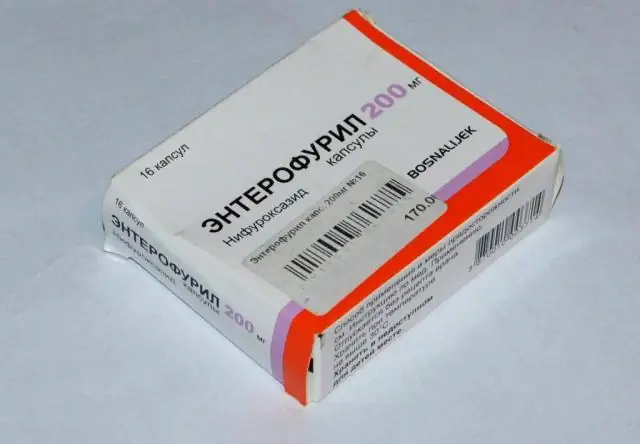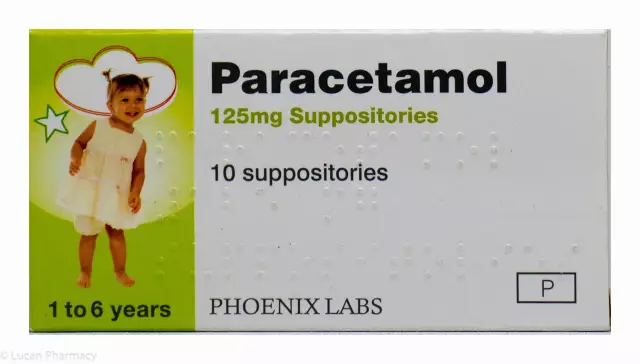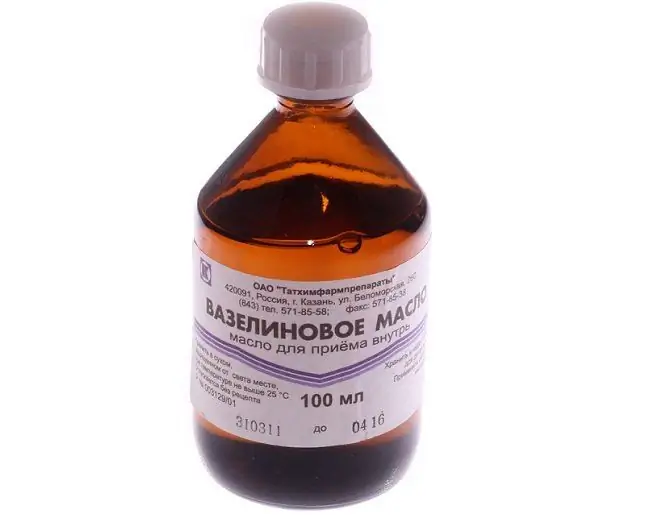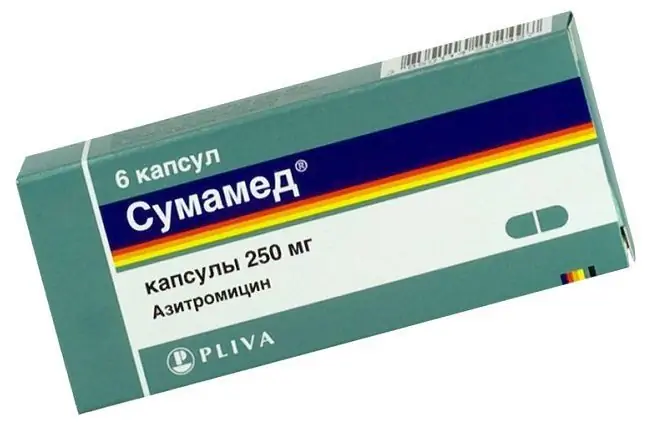- Author Rachel Wainwright [email protected].
- Public 2023-12-15 07:39.
- Last modified 2025-11-02 20:14.
Paracetamol for children
Paracetamol for children: instructions for use and reviews
- 1. Release form and composition
- 2. Pharmacological properties
- 3. Indications for use
- 4. Contraindications
- 5. Method of application and dosage
- 6. Side effects
- 7. Overdose
- 8. Special instructions
- 9. Application during pregnancy and lactation
- 10. Use aged
- 11. In case of impaired renal function
- 12. For violations of liver function
- 13. Use in the elderly
- 14. Drug interactions
- 15. Analogs
- 16. Terms and conditions of storage
- 17. Terms of dispensing from pharmacies
- 18. Reviews
- 19. Price in pharmacies
Latin name: Paracetamol children
ATX code: N02BE01
Active ingredient: Paracetamol (Paracetamol)
Producer: Rozpharm LLC, Pharmstandard-Leksredstva, Biochemist, Pharmproject, Dalkhimfarm, Irbitskiy Khimfarmzavod, Pharmapol-Volga, Mega Pharm (Russia), Anqiu Lu An Pharmaceutical Co. (China), LLC Pharmaceutical company "Health" (Ukraine)
Description and photo update: 19.10.2018
Prices in pharmacies: from 59 rubles.
Buy

Paracetamol for children is a non-narcotic analgesic.
Release form and composition
The dosage form of release is a suspension for oral administration: homogeneous, pink, with a characteristic fruity odor (100 and 200 ml each in polymer bottles, or orange glass bottles, or from glass melt, or from polyethylene terephthalate for medicines, sealed with a polymer screw cap with control of the first opening or the “push-turn” system, 1 bottle in a cardboard box without / with a measuring cup or measuring spoon).
Composition of 100 ml suspension:
- active substance: paracetamol - 2.4 g;
- additional components: sodium nipasept (sodium ethyl parahydroxybenzoate, sodium methyl parahydroxybenzoate and sodium propyl parahydroxybenzoate) - 0.15 g, maltitol - 80 g, malic acid - 0.05 g, non-crystallizing sorbitol 70% - 1.33 g, xanthan gum - 0.6 g, anhydrous citric acid - 0.02 g, azorubin dye - 0.001 g, strawberry or orange flavor - 0.1 g, water - up to 100 ml.
Pharmacological properties
Pharmacodynamics
Paracetamol is a medicinal substance that has antipyretic and analgesic effects. It practically does not have anti-inflammatory properties.
The mechanism of action is due to the ability to block cyclooxygenase in the central nervous system, acting on the centers of thermoregulation and pain.
The drug has practically no anti-inflammatory properties. It does not affect water and electrolyte metabolism and the state of the mucous membrane of the gastrointestinal tract (GIT), since it affects the synthesis of prostaglandins in peripheral tissues to a very small extent.
Pharmacokinetics
Paracetamol is characterized by high absorption, it is rapidly and almost completely absorbed from the gastrointestinal tract. It binds to plasma proteins by 10-25%. The maximum plasma concentration is reached after 30-120 minutes and is 5-20 μg / ml.
The drug crosses the blood-brain barrier. Less than 1% of the dose is passed into the mother's breast milk. The distribution of the substance in body fluids is relatively uniform.
Paracetamol is metabolized mainly in the liver in three main ways, such as oxidation by microsomal liver enzymes, conjugation with sulfates and conjugation with glucuronides. During oxidation, intermediate toxic metabolites are formed, which are subsequently conjugated first with glutathione, then with mercapturic acid and cysteine. For this method of metabolism, the main isoenzymes of the cytochrome P 450 system are CYP2E1 (mainly), CYP1A2 and CYP3A4 (minor role). In the case of a glutathione deficiency in the body, these metabolites can cause damage and necrosis of hepatocytes. Additional metabolic pathways are methoxylation to 3-methoxyparacetamol and hydroxylation to 3-hydroxyparacetamol, which are subsequently conjugated to sulfates or glucuronides.
In children under the age of 10 years, the main metabolite of the drug is paracetamol sulfate, in children from 12 years of age - conjugated glucuronide.
The conjugated metabolites of paracetamol (conjugates with glutathione, sulfates, glucuronides) are characterized by low pharmacological activity, including toxic.
When taking a therapeutic dose, the total clearance is 18 l / h, the half-life (T ½) is from 1 to 4 hours. When taking therapeutic doses, 90-100% of the taken dose of paracetamol is excreted in the urine within 24 hours. The main amount of the drug after conjugation is excreted in the liver in the form of glucuronide (60-80%) and sulfate (20-30%). About 5% of the dose is excreted unchanged.
In elderly patients, paracetamol clearance decreases and T ½ increases.
In patients with severe renal failure (creatinine clearance 10-30 ml / minute), paracetamol excretion slows down, the rate of excretion of sulfate and glucuronide is lower than in healthy individuals.
Indications for use
Suspension Paracetamol for children is prescribed for children aged 3 months to 12 years in the following cases:
- increased body temperature due to influenza, colds and childhood infectious diseases such as scarlet fever, chicken pox, measles, mumps, etc.;
- toothache, including when teething or removing teeth, ear pain with otitis media, headache, sore throat.
On the recommendation of a doctor, children 2-3 months of age can take a single dose in case of increased body temperature after vaccination.
Contraindications
- intolerance to fructose;
- severe impairment of renal or hepatic function;
- age under 2 months;
- simultaneous use of other medicines containing paracetamol;
- hypersensitivity to any component of the drug.
Carefully:
- liver dysfunction, including Gilbert's syndrome;
- viral hepatitis;
- genetic absence of the enzyme glucose-6-phosphate dehydrogenase;
- impaired renal function (creatinine clearance <30 ml / min);
- anorexia / bulimia;
- dehydration;
- hypovolemia;
- severe blood diseases (leukopenia, severe anemia, thrombocytopenia);
- diabetes;
- chronic alcoholism.
Instructions for the use of Paracetamol for children: method and dosage
Suspension Paracetamol for children should be taken orally, preferably 1-2 hours after meals, with plenty of liquid. Shake well immediately before taking. For correct dosage, a measuring spoon or cup is usually included in the package.
The optimal dose is determined taking into account the age and body weight of the child.
For children older than 3 months, a single dose of paracetamol is 10-15 mg / kg, the frequency of administration is 3-4 times a day. The highest daily dose should not exceed 60 mg / kg.
The drug can be taken in 1 dose at intervals of 4-6 hours, but no more than 4 times during the day.
Recommended dosages of Paracetamol for children, depending on age and body weight - single dose in ml (mg) / maximum daily dose in ml (mg):
- 2-3 months (4.5-6 kg): it is possible to use the drug only as directed by a doctor *;
- 3-6 months (6-8 kg): 4 ml (96 mg) / 16 ml (384 mg);
- 6-12 months (8-10 kg): 5 ml (120 mg) / 20 ml (480 mg);
- 1-2 years (10-13 kg): 7 ml (168 mg) / 28 ml (672 mg);
- 2-3 years (13-15 kg): 9 ml (216 mg) / 36 ml (864 mg);
- 3-6 years (15-21 kg): 10 ml (240 mg) / 40 ml (960 mg);
- 6-9 years (21-29 kg): 14 ml (336 mg) / 56 ml (1344 mg);
- 9-12 years (29-42 kg): 20 ml (480 mg) / 80 ml (1920 mg).
Unless otherwise prescribed by a doctor, the drug can be used for no more than 3 days.
* Single dosage of Paracetamol for children for children 2-3 months - 10-15 mg / kg with a frequency of administration 1-2 times a day. If the temperature does not decrease after taking the second dose, you should consult a doctor. For other indications, children 2-3 months of age can be given the drug only as directed by a pediatrician.
Children with impaired renal function need to increase the interval between doses. With creatinine clearance (CC) of 10-50 ml / minute, it should be at least 6 hours, with CC <10 ml / minute - 8 hours.
Side effects
Grouping of adverse events by frequency (according to post-registration data): very often - ≥ 1/10, often - from ≥ 1/100 to <1/10, infrequently - from ≥ 1/1000 to <1/100, rarely - from ≥ 1 / 10,000 to <1/1000, very rarely - <1/10 000, unknown - it is not possible to establish the frequency based on the available data.
Paracetamol can cause the following side effects:
- from the gastrointestinal tract: rarely - nausea, abdominal pain, diarrhea, vomiting;
- from the blood and lymphatic system: rarely - thrombocytopenia, anemia, leukopenia;
- from the liver and biliary tract: very rarely - liver dysfunction; with long-term use in large doses - nephrotoxic and hepatotoxic effects;
- from the immune system: very rarely - Quincke's edema, anaphylaxis;
- from the respiratory system: very rarely, with increased sensitivity to acetylsalicylic acid or intolerance to other nonsteroidal anti-inflammatory drugs (NSAIDs) - bronchospasm;
- from the skin and subcutaneous tissues: very rarely - skin reactions of hypersensitivity, including skin rash, urticaria, itching of the skin, Lyell's syndrome (toxic epidermal necrolysis), acute generalized exanthematous pustulosis, Stevens-Johnson syndrome.
Overdose
In case of an overdose, there is a risk of intoxication, especially in patients receiving simultaneously inducers of microsomal liver enzymes, in persons with malnutrition, in patients with liver diseases and in children. As a result, cholestatic hepatitis, liver failure, cytolytic hepatitis, fulminant hepatitis, sometimes fatal, may occur.
Symptoms of acute poisoning: pallor of the skin, stomach pain, nausea, vomiting, anorexia, metabolic acidosis, impaired glucose metabolism (sweating, dizziness, loss of consciousness). After 1-3 days, signs of liver damage appear (pain in the liver, a decrease in the level of prothrombin, an increase in the concentration of bilirubin and the activity of liver enzymes), which reach a maximum on 3-4 days. In the case of simultaneous reception of paracetamol by an adult at a dose of 10,000 mg, children - from 125 mg / kg, hepatitis cytolysis occurs with the development of encephalopathy, metabolic acidosis, complete and irreversible liver necrosis, liver failure - serious complications that can lead to coma and fatal the outcome.
In case of severe overdose, progressive encephalopathy, liver failure, coma, death occurs. Acute renal failure with tubular necrosis without severe liver damage may also develop. Its characteristic features are lower back pain, proteinuria, hematuria, as well as pancreatitis and arrhythmia.
In the case of prolonged use of the drug in doses exceeding the recommended ones, the development of hepatotoxic and nephrotoxic effects is possible: nonspecific bacteriuria, renal colic, interstitial nephritis and papillary necrosis.
In case of an overdose, you should stop taking paracetamol, if possible, make a gastric lavage, take an enterosorbent (activated carbon or polyphepan) and immediately consult a doctor. Treatment is mostly symptomatic. As soon as possible after an overdose, it is necessary to determine the content of paracetamol in blood plasma. In case of poisoning, SH-group donors, acetylcysteine and methionine (precursors of glutathione synthesis) should be administered within the first 10 hours. The need for additional therapeutic measures (including the further administration of methionine and acetylcysteine) is determined by the doctor depending on the level of paracetamol in the blood and the time elapsed since its administration. At the beginning of treatment and then every 24 hours, liver tests are performed. Liver enzymes in most cases return to normal within 1 to 2 weeks. In case of severe overdose, a liver transplant may be required.
If a child accidentally takes the drug on his own, you should urgently seek medical help, even if he feels well. In 24 hours after taking paracetamol, in case of serious liver disorders, treatment is carried out in conjunction with specialists from a specialized department of hepatology or a toxicological center.
special instructions
To avoid overdose during the period of treatment with this drug, you should not simultaneously take other drugs containing paracetamol.
For children 2-3 months, the drug can only be given as directed by a pediatrician.
Care should be taken when a patient is diagnosed with a glutathione deficiency, as the risk of overdose is increased. In addition, liver failure has been reported in patients with low glutathione levels, particularly in very malnourished people with anorexia, patients with low body mass index, and those with chronic alcoholism. Also, in some cases, such as sepsis, paracetamol increased the risk of developing metabolic acidosis.
The drug can distort the results of laboratory tests for the content of glucose and uric acid in the blood.
If it is necessary to use the drug for more than 5 days, it is recommended to monitor the peripheral blood parameters and the functional state of the liver.
If there is no effect within 3 days of taking the drug, you should consult your doctor.
Influence on the ability to drive vehicles and complex mechanisms
Paracetamol does not affect the speed of reactions and the ability to concentrate.
Application during pregnancy and lactation
The negative effect of paracetamol during its use during pregnancy and lactation was not noted. The drug penetrates the placental barrier, is excreted in breast milk (no more than 0.23% of the dose taken by the mother). In experimental studies, neither teratogenic, nor embryotoxic, nor mutagenic effect of the substance was established. However, for pregnant and breastfeeding women, paracetamol is prescribed only after assessing the intended benefits and potential risks.
There is no data on the effect on fertility.
Pediatric use
According to the instructions, Paracetamol for children is strictly contraindicated in children under 2 months. At the age of 2 to 3 months, it can be used once to reduce fever after vaccination. From the age of 3 months, it is used according to the dosage regimen specified in the instructions.
With impaired renal function
Paracetamol should be used with caution in patients with impaired renal function.
In addition, it is necessary to increase the interval between doses: with CC 10-50 ml / minute - up to 6 hours, with CC <10 ml / minute - up to 8 hours.
For violations of liver function
Paracetamol should be used with caution in patients with impaired hepatic function.
Use in the elderly
In old age, drugs containing paracetamol should be used under close medical supervision.
Drug interactions
Care should be taken if it is necessary to jointly use drugs that induce liver microsomal enzymes, such as ethanol, barbiturates, phenylbutazone, anticoagulants, rifampicin, tricyclic antidepressants, zidovudine, isoniazid, anticonvulsants, amoxicillin + clavulanic acid.
St. John's wort preparations, butadione and flumecinol increase the production of hydroxylated active metabolites, as a result of which, in case of an overdose (taking 5000 mg or more), the risk of developing severe liver damage increases.
Paracetamol increases the elimination time of chloramphenicol by 5 times, which increases the likelihood of poisoning. Reduces the effectiveness of uricosuric drugs.
Paracetamol, taken in a daily dose of 4000 mg for 4 or more days, with simultaneous administration can enhance the effect of indirect anticoagulants, therefore, the International Normalized Ratio should be monitored during and after taking such a combination. If paracetamol is taken irregularly, it has no significant effect on the effect of anticoagulants.
Long-term concomitant use of other NSAIDs increases the risk of developing renal papillary necrosis, "analgesic" nephropathy and end-stage renal failure.
Alcohol consumed during treatment with paracetamol contributes to the development of acute pancreatitis.
The simultaneous long-term use of paracetamol in high doses in combination with salicylates increases the risk of developing cancer of the bladder or kidney.
Possible drug effects of other drugs on paracetamol:
- probenecid almost halves its clearance by inhibiting the process of its conjugation with glucuronic acid;
- domperidone and metoclopramide increase the rate of its absorption;
- cholestyramine reduces the rate of its absorption;
- long-term use of barbiturates reduces its effectiveness;
- diflunisal doubles its plasma concentration, which increases the risk of hepatotoxicity;
- phenytoin reduces its effect and increases the risk of developing hepatotoxicity;
- myelotoxic agents increase the manifestations of its hematotoxicity.
Inhibitors of microsomal oxidation (including cimetidine), when used simultaneously, reduce the risk of hepatotoxic action.
Analogs
Children's Paracetamol analogues are: Paracetamol (suspension), Calpol, Daleron, Children's Panadol.
Terms and conditions of storage
Shelf life is 3 years.
Storage conditions: protected from light, place inaccessible to children, temperature up to 25 ° С.
Terms of dispensing from pharmacies
Available without a prescription.
Reviews of Paracetamol for children
Reviews of Paracetamol for children are positive: the drug effectively relieves pain and reduces fever.
Price for Paracetamol for children in pharmacies
On average, the price of Paracetamol for children is 60 rubles for a 100 ml bottle and 100 rubles for a 200 ml bottle.
Paracetamol for children: prices in online pharmacies
|
Drug name Price Pharmacy |
|
Paracetamol for children 120 mg / 5 ml suspension for oral administration for children strawberry (s) 100 g 1 pc. RUB 59 Buy |
|
Paracetamol for children 120 mg / 5 ml oral suspension 100 ml 1 pc. RUB 61 Buy |
|
Paracetamol for children 120 mg / 5 ml suspension for oral administration for children with orange flavor 200 g 1 pc. RUB 104 Buy |

Maria Kulkes Medical journalist About the author
Education: First Moscow State Medical University named after I. M. Sechenov, specialty "General Medicine".
Information about the drug is generalized, provided for informational purposes only and does not replace the official instructions. Self-medication is hazardous to health!






